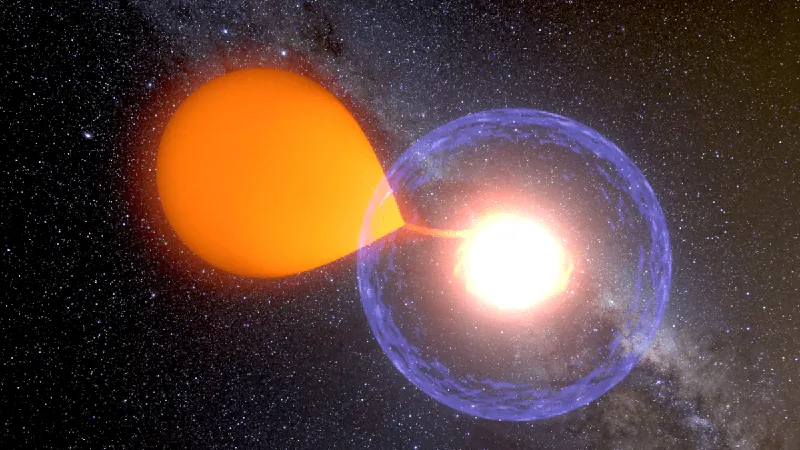
Cosmic X-Ray Mystery Unveiled: Scientists Identity a New Class of Exploding Stars!
2024-12-31
Author: Ming
Introduction
In a thrilling new astronomical breakthrough, researchers have discovered an entirely new category of stellar fireworks, known as "millinovae." This discovery could revolutionize our understanding of cosmic phenomena and provide answers to longstanding mysteries about the universe.
The Discovery
Astronomers from the University of Warsaw, leading an international research team, have identified 29 of these mysterious stellar systems within our galactic neighborhood, specifically in the Large and Small Magellanic Clouds—two dwarf galaxies that orbit our Milky Way. Their findings, published in The Astrophysical Journal Letters, reveal a previously unrecognized type of binary star system that undergoes periodic bright outbursts.
Understanding Millinovae
Dr. Przemek Mróz, the lead author of the study, explained, “Some cosmic phenomena produce X-rays naturally. For example, X-rays can be generated by hot gas falling onto dense objects like white dwarfs or black holes.” The heart of each millanova is a captivating interaction between a white dwarf—a dense remnant of a former star—and its companion star. The white dwarf’s intense gravitational pull draws material from its partner, forming a disk of heated gas. This gravitational tango occasionally results in spectacular outbursts lasting months.
The Pioneering Star System
The groundbreaking research began with the peculiar star system ASASSN-16oh, discovered in 2016. Unlike typical nova explosions, which brighten quickly, ASASSN-16oh exhibited an unusual, prolonged rise in brightness accompanied by supersoft X-rays—an indicator of intense cosmic activity. To assess whether ASASSN-16oh was unique or part of a larger population, Dr. Mróz and his team sifted through two decades of data from the Optical Gravitational Lensing Experiment (OGLE), examining light curves of 76 million stars and identifying 29 similar systems.
Observations and Findings
One of their key observations occurred when OGLE-mNOVA-11 began an outburst in November 2023. Using the Southern African Large Telescope, the team detected ionized gas signatures—helium, carbon, and nitrogen—indicating incredibly high temperatures. Notably, OGLE-mNOVA-11 was producing X-rays associated with a staggering temperature of 600,000 degrees Celsius and was emitting more than 100 times the luminosity of our Sun, despite being over 160,000 light-years away.
Explaining the X-Rays
However, the precise source of the X-rays remains a subject of exploration. Researchers propose two theories: either the X-rays are generated as gas from a companion subgiant star falls onto the white dwarf, or through a thermonuclear process on the white dwarf’s surface, where hydrogen ignites but does not produce a significant explosion.
Implications for Stellar Evolution
The implications of discovering millinovae in stellar evolution are monumental. This new class could help uncover the mysteries surrounding Type Ia supernovae—key stellar explosions that serve as "standard candles" for measuring cosmic distances. These extraordinary events contributed to the groundbreaking discovery of the universe's accelerating expansion, a finding that earned the Nobel Prize in Physics in 2011.
Conclusion
If millinovae are indeed a pathway for white dwarfs to amass mass gradually without violent eruptions, they may bridge a crucial gap in our understanding of how these stars reach the critical mass needed for Type Ia supernovae—approximately 1.4 times that of our Sun. As we continue to explore the cosmos, discoveries like millinovae offer a compelling reminder that the universe is brimming with surprises, and many secrets are yet to be uncovered. Stay tuned as astronomers delve deeper into this intriguing new realm of binary star systems!
 Brasil (PT)
Brasil (PT)
 Canada (EN)
Canada (EN)
 Chile (ES)
Chile (ES)
 Česko (CS)
Česko (CS)
 대한민국 (KO)
대한민국 (KO)
 España (ES)
España (ES)
 France (FR)
France (FR)
 Hong Kong (EN)
Hong Kong (EN)
 Italia (IT)
Italia (IT)
 日本 (JA)
日本 (JA)
 Magyarország (HU)
Magyarország (HU)
 Norge (NO)
Norge (NO)
 Polska (PL)
Polska (PL)
 Schweiz (DE)
Schweiz (DE)
 Singapore (EN)
Singapore (EN)
 Sverige (SV)
Sverige (SV)
 Suomi (FI)
Suomi (FI)
 Türkiye (TR)
Türkiye (TR)
 الإمارات العربية المتحدة (AR)
الإمارات العربية المتحدة (AR)